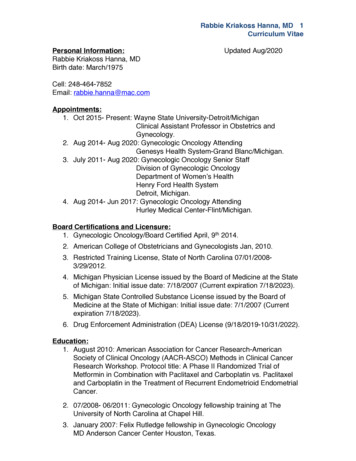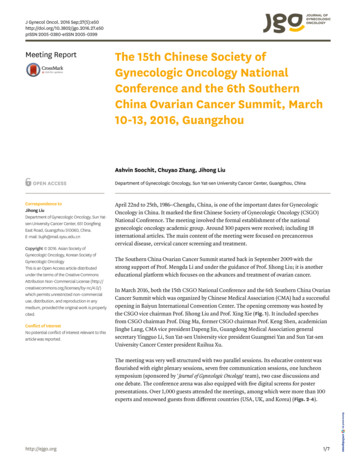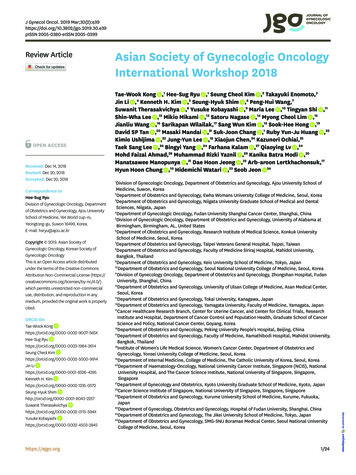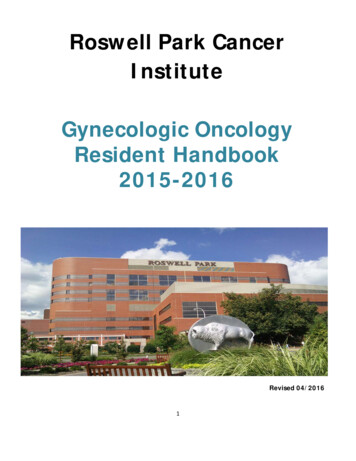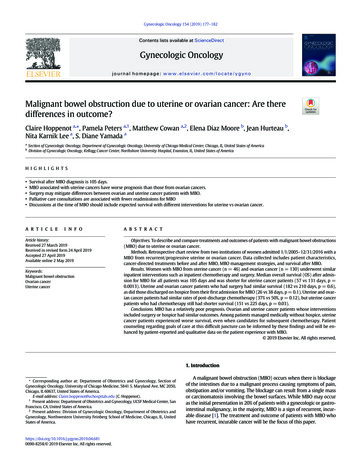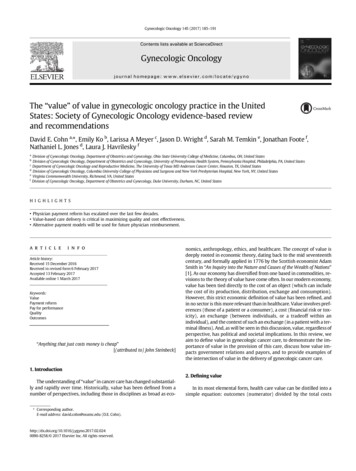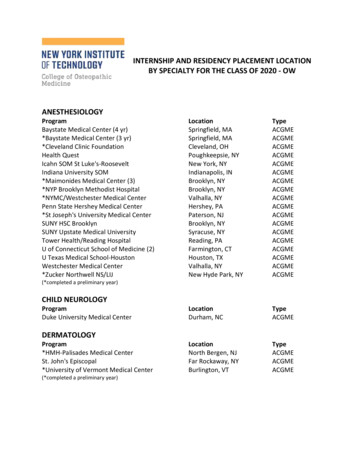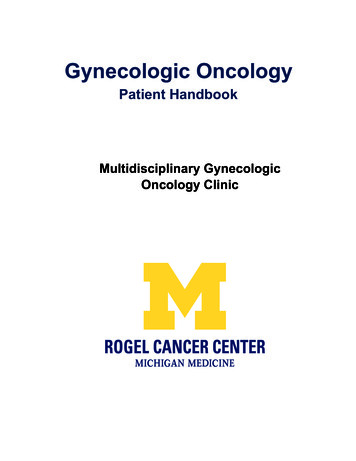Transcription
Gynecologic Oncology Supplemental GuideSupplemental Guide:Gynecologic OncologyMarch 20221
Gynecologic Oncology Supplemental GuideTABLE OF CONTENTSINTRODUCTION . 4PATIENT CARE . 5Surgical Care of Gynecologic Cancer – Open Techniques . 5Surgical Care of Gynecologic Cancer – Minimally Invasive Surgical Techniques . 7Management Chemotherapy and Targeted Therapeutics . 9Peri-Operative Care (Pre-, Intra-, and Post-) . 10Palliative Symptom Management . 11MEDICAL KNOWLEDGE . 12Anatomy . 12Medical Diseases in Gynecologic Cancer – Organ System Disorders . 14Genetics, Cancer Biology, and Immunology . 15Radiation Therapy – Radiation Biology and Physics . 17Chemotherapy and Targeted Therapeutics . 19Diagnostic Techniques and Treatment Planning . 20Clinical Studies . 22End-of-Life Care . 23SYSTEMS-BASED PRACTICE . 25Patient Safety and Quality Improvement. 25System Navigation for Patient-Centered Care . 27Community and Population Health . 29Physician Role in Health Care Systems . 30PRACTICE-BASED LEARNING AND IMPROVEMENT . 32Evidence-Based and Informed Practice . 32Reflective Practice and Commitment to Personal Growth . 34Scholarly Activity . 36PROFESSIONALISM . 38Professional Behavior and Ethical Principles . 38Accountability/Conscientiousness . 40Well-Being . 41INTERPERSONAL AND COMMUNICATION SKILLS . 42Patient- and Family-Centered Communication and Shared Decision Making . 42Critical Cancer Conversations . 44Interprofessional and Team Communication . 462
Gynecologic Oncology Supplemental GuideCommunication within Health Care Systems . 48MAPPING OF 1.0 TO 2.0 . 50RESOURCES . 513
Gynecologic Oncology Supplemental GuideMilestones Supplemental GuideThis document provides additional guidance and examples for the Gynecologic Oncology Milestones. This is not designed to indicateany specific requirements for each level, but to provide insight into the thinking of the Milestone Work Group.Included in this document is the intent of each Milestone and examples of what a Clinical Competency Committee (CCC) mightexpect to be observed/assessed at each level. Also included are suggested assessment models and tools for each subcompetency,references, and other useful information.New in this version of the milestones are harmonized milestones that have been kept intentionally relatively consistent acrossspecialties and across levels of the educational program (residency and fellowship). The CCC might be expected to find that fellowscome in at a higher level (perhaps Level 3-4 rather than Level 1-2) for the harmonized milestones, as new fellows will havepresumably progressed to higher levels of similar milestones prior to residency completion.Review this guide with the CCC and faculty members. As the program develops a shared mental model of the Milestones, considercreating an individualized guide (Supplemental Guide Template available) with institution/program-specific examples, assessmenttools used by the program, and curricular components.Additional tools and references, including the Milestones Guidebook, Clinical Competency Committee Guidebook, and MilestonesGuidebook for Residents and Fellows, are available on the Resources page of the Milestones section of the ACGME website.4
Gynecologic Oncology Supplemental GuidePatient Care 1: Surgical Care of Gynecologic Cancer – Open TechniquesOverall Intent: To have the knowledge and clinical experience necessary to safely perform and demonstrate progressive technical skill inopen gynecologic oncology proceduresMilestonesExamplesLevel 1 Independently selects appropriate Identifies patients appropriate for wide local excision, cold knife cone, and hysterectomyprocedures for benign gynecologic conditionsProficiently performs benign gynecologic orbasic cancer-specific proceduresLevel 2 Proposes appropriate cancer-specificprocedures Performs wide local excision, cold knife cone, and hysterectomyEffectively assists during radical cancer-specificproceduresLevel 3 Selects appropriate cancer-specificprocedures Assists with radical hysterectomy, radical vulvectomy, and cancer staging/debulkingprocedures Performs radical hysterectomy, radical vulvectomy, and staging / debulking procedures Performs lymphadenectomyPerforms radical cancer-specific proceduresLevel 4 Independently adapts surgical planbased on unforeseen intraoperative eventsIndependently and proficiently performs radicalcancer-specific proceduresLevel 5 Independently manages complicated ormultidisciplinary procedures for patients withmultiple comorbiditiesIdentifies innovative techniques and approachesfrom the literature or other disciplinesAssessment Models or ToolsCurriculum Mapping Identifies patients appropriate for radical hysterectomy, radical vulvectomy, and cancerstaging/debulking Proficient with radical hysterectomy, radical vulvectomy, staging/ debulking procedures Restores normal anatomy with severe adhesions Manages unexpected intra-operative complications Coordinates multidisciplinary surgical team such as a reconstructive flap in conjunctionwith an exenterative procedure Direct observation Global evaluation Multisource feedback Oral examination Portfolio Simulation assessment 5
Gynecologic Oncology Supplemental GuideNotes or Resources Atlas of Pelvic Surgery. Malignant Disease: Special alignantDisease/chapter10index.html. 2021. National Comprehensive Cancer Network (NCCN). NCCN y 1. 2021. Society of Gynecologic Oncology (SGO). ConnectED. https://connected.sgo.org/. 2021. Surgical textbooks6
Gynecologic Oncology Supplemental GuidePatient Care 2: Surgical Care of Gynecologic Cancer – Minimally Invasive Surgical TechniquesOverall Intent: To have the knowledge and clinical experience necessary to safely perform and demonstrate progressive technical skill inminimally invasive gynecologic oncology proceduresMilestonesExamplesLevel 1 Independently selects appropriate Lists appropriate route of hysterectomy based on patient and uterine factors and safelyprocedures for benign gynecologic conditionsperforms a vaginal and minimally invasive hysterectomyProficiently performs benign gynecologic orbasic cancer-specific proceduresLevel 2 Proposes appropriate cancer-specificprocedures Understands indications for sentinel lymph node assessment in endometrial cancerEffectively assists during radical cancer-specificproceduresLevel 3 Selects appropriate cancer-specificprocedures Functions as first assistant to facilitate safe minimally invasive surgery staging proceduresPerforms radical cancer-specific proceduresLevel 4 Independently adapts surgical planbased on unforeseen intraoperative events Safely performs pelvic lymphadenectomy with supervision Describes staging for non-mapping sentinel lymph node in endometrial cancer Independently performs minimally invasive surgical dissection (e.g., lymphadenectomy) Troubleshoots technical and logistic obstacles to performing minimally invasive surgicalproceduresIndependently and proficiently performs radicalcancer-specific proceduresLevel 5 Independently manages complicated ormultidisciplinary procedures for patients withmultiple comorbiditiesIdentifies innovative techniques and approachesfrom the literature or other disciplinesAssessment Models or ToolsCurriculum Mapping Identifies indications for pelvic lymphadenectomy Coordinates complex surgery for a patient with morbid obesity who has endometrialcancer and a large ventral hernia Proposes a new strategy for less invasive staging based on literature from other fields Direct observation Global evaluation Multisource feedback Oral examination Portfolio Simulation assessment 7
Gynecologic Oncology Supplemental GuideNotes or Resources Atlas of Pelvic Surgery. Malignant Disease: Special alignantDisease/chapter10index.html. 2021. NCCN. NCCN Guidelines. https://www.nccn.org/guidelines/category 1. 2021. SGO. ConnectED. https://connected.sgo.org/. 2021. Surgical textbooks8
Gynecologic Oncology Supplemental GuidePatient Care 3: Management Chemotherapy and Targeted TherapeuticsOverall Intent: To appropriately use chemotherapy and targeted therapies to manage/treat gynecologic malignanciesMilestonesLevel 1 Discusses commonly usedchemotherapy agents, targeted therapeutics,and common toxicitiesLevel 2 Proposes appropriate options fortreatment based on guidelinesLevel 3 Selects appropriate chemotherapyagents and targeted therapies for treatmentbased on observed toxicities and guidelinesLevel 4 Independently adapts chemotherapyagents and targeted therapies based ongenetics, tumor testing, and/or toxicitiesLevel 5 Independently manages acute and longterm toxicities and makes appropriate referralsto other members of the interdisciplinary teamAssessment Models or ToolsCurriculum MappingNotes or ResourcesExamples Cites resources such as national guidelines for essential indications for cancer therapies Is aware of dose limiting toxicities of commonly prescribed chemotherapies Selects right treatment based on stage, toxicity, and goals of therapy Effectively reduces dose based on new patient symptoms and lab values (e.g., anticancertoxicities) Uses both germline and tumor testing to develop individualized treatment plans forrecurrent ovarian cancer Proactively works with other specialties to manage rare complications of therapy Clinical case reviews Direct observation Medical record (chart) audit Tumor board American Society of Clinical Oncology (ASCO). Guidelines, Tools, & uidelines. 2021. NCCN. NCCN Guidelines. https://www.nccn.org/guidelines/category 1. 2021. Textbooks9
Gynecologic Oncology Supplemental GuidePatient Care 4: Peri-Operative Care (Pre-, Intra-, and Post-)Overall Intent: To effectively avoid, identify, and manage conditions/situations/complications that impact peri-operative careMilestonesLevel 1 Assesses peri-operative surgical riskand manages routine peri-operative careLevel 2 Employs standardized care protocolsand recognizes common peri-operativecomplicationsLevel 3 Manages patients with complex perioperative needs and common peri-operativecomplicationsLevel 4 Independently manages patients withcomplex peri-operative needs and complex perioperative complications, integrating principles ofcritical careLevel 5 Identifies gaps in peri-operativemanagement and complications to beaddressed in quality improvement/researchinitiativesAssessment Models or ToolsCurriculum MappingNotes or ResourcesExamples Identifies comorbid conditions (renal/heart disease, obesity, thromboembolic disease,dementia) and their contribution to peri-operative risk Identifies the appropriate use of intra-operative antibiotics Manages the care of uncomplicated post-operative patients: fluid management, postoperative milestones Uses institutional Enhanced Recovery After Surgery (ERAS) protocol References American College of Chest Physicians (CHEST) guidelines for venousthromboembolism prevention Recognizes urinary retention or oliguria Manages urinary retention or oliguria Manages peri-operative anticoagulation for patients with venous thromboembolism Manages cystotomy Understands the indications for and principles behind massive transfusion protocol Engages in collaborative discussion with anesthesia Independently manages post-operative ureteral injury or acute abdomen Independently escalates care as appropriate Coordinates multidisciplinary discussion for complex patients Engages in root cause analysis Leads morbidity/mortality discussion Chart review Direct observation Multisource feedback Oral examination Patient care conferences American College of Surgeons (ACS). ACS NSQIP Surgical Risk culator/. 2021. National clinical guidelines Textbooks10
Gynecologic Oncology Supplemental GuidePatient Care 5: Palliative Symptom ManagementOverall Intent: To assess, manage, and optimize cancer/treatment-related symptomsMilestonesLevel 1 Takes a complete cancer andtreatment-related symptom historyLevel 2 Manages uncomplicated symptomsintegrating standardized symptom assessmenttoolsLevel 3 Manages complex symptomsLevel 4 Coordinates multidisciplinarymanagement of complex and refractorysymptomsLevel 5 Applies innovative approaches tosymptom managementAssessment Models or ToolsCurriculum MappingNotes or ResourcesExamples Assesses cancer pain and symptoms of therapy (nausea, constipation) Assesses social support Proposes initial management for fatigue, neuropathy, or palmar-plantarerythrodysesthesia Uses standardized symptom assessment tools Manages refractory pain, bowel obstruction, ascites, dyspnea Coordinates a multidisciplinary team (gynecology oncology, radiation oncology,anesthesiology, pain management) to address refractory symptoms Identifies the need for nerve blocks, lidocaine infusions, palliative radiation, or G-tubes Creates research study to evaluate new treatment option Conducts a quality improvement (QI) project to systematically assess pain among cancerpatients Chart review Direct observation Multisource feedback Patient care conference Patient feedback ASCO. Guidelines, Tools, & Resources. https://www.asco.org/practicepatients/guidelines. 2021. Center to Advance Palliative Care (CAPC). Symptom anagement/. 2021. Gyn Oncology textbooks NCCN. NCCN Guidelines. https://www.nccn.org/guidelines/category 1. 2021. Palliative Care Network of Wisconsin (PCNOW). Fast Facts and Concepts.https://www.mypcnow.org/fast-facts/. 2021.11
Gynecologic Oncology Supplemental GuideMedical Knowledge 1: AnatomyOverall Intent: Acquires and uses extensive knowledge of relevant anatomy in gynecologic cancer surgeryMilestonesLevel 1 Demonstrates knowledge of pelvicanatomyExamples Identifies pelvic organs, external genitalia, pelvic floor, musculoskeletal structures,vascular supply, and pelvic organ innervationApplies knowledge of normal pelvic anatomy inthe surgical setting to reduce surgicalcomplication and morbidityLevel 2 Demonstrates knowledge of normalretroperitoneal and upper abdominal anatomy. Proactively identifies the ureter and protects it from injury during hysterectomyApplies knowledge of pelvic anatomy distortedby gynecologic cancer in complex surgicalsetting to reduce surgical complication andmorbidityLevel 3 Applies knowledge of pelvic,retroperitoneal, and upper abdominal anatomydistorted by gynecologic cancer in astraightforward surgical setting to reducesurgical complications and morbidity Performs ureterolysis to move the ureter into a safe position Opens pelvic spacesApplies knowledge of pelvic anatomy, upperabdominal and retroperitoneal anatomy whenreviewing diagnostic studiesLevel 4 Applies knowledge of pelvic,retroperitoneal, and upper abdominal anatomydistorted by gynecologic cancer in a complexsurgical setting to reduce surgical complicationsand morbidity Identifies point of ureteral obstruction in patient with a hydronephrosisApplies knowledge of pelvic anatomy, upperabdominal and retroperitoneal anatomy whenplanning complex surgical intervention Uses imaging studies to plan complex surgery for removal of pelvic sidewall recurrence Identifies retroperitoneal, porta-hepatis, splenic, and upper abdominal anatomy Removes an enlarged obturator lymph node without injury to the obturator nerve Removes an enlarged para-aortic lymph node without injuring the vena cava Safely performs en bloc pelvic resection of uterus and sigmoid colon12
Gynecologic Oncology Supplemental GuideLevel 5 Applies knowledge of pelvic andabdominal anatomy to complex surgical casesand identifies areas for surgical innovation andquality improvementAssessment Models or ToolsCurriculum MappingNotes or Resources Engages with other surgical consultants to gain novel surgical skills such aslymphovenous bypass or creation of a myocutaneous flap Case-based assessment Direct observation Anatomic text and gynecologic oncology texts Clinical case reviews Surgical case logs and evaluations of surgical cases Tumor board or other conferences utilizing imaging13
Gynecologic Oncology Supplemental GuideMedical Knowledge 2: Medical Diseases in Gynecologic Cancer – Organ System DisordersOverall Intent: To have sufficient knowledge of systemic disease and comorbid conditions to safely treat gynecologic oncology patientsMilestonesLevel 1 Demonstrates knowledge of commonmedical conditions that can affect patientoutcomesLevel 2 Applies knowledge of common medicalco-morbidities to optimize patient outcomesLevel 3 Demonstrates knowledge of complexorgan system disorders, metabolicderangements, and coagulopathiesLevel 4 Applies knowledge of complex organsystem disorders to optimize patient outcomesLevel 5 Applies an evidence-based approach toinnovative management of the gynecologiccancer patient with complex medical conditionsAssessment Models or ToolsCurriculum MappingNotes or ResourcesExamples Interprets hemoglobin A1C level and diastolic blood pressure levels Recognizes acquired or inherited clotting disorders Understands rationale for tight glucose control peri-operatively and develops effectiveplan Differentiates mechanisms of action and half-life of common classes of anticoagulantsand appropriately manages for safe peri-operative care Modifies surgical plan to optimize peri-operative outcome in patients with abnormalhemoglobin A1C or blood pressure Is aware of competing effects of medical conditions (e.g., congestive heart failure, renalfailure, coagulopathies) and administration of chemotherapy Effectively integrates dose limiting toxicities and mechanism of clearance of anticancertherapies with coexisting medical conditions Recognizes severe or specialized medical comorbidities that require multidisciplinary careto achieve best outcomes Organizes and runs multidisciplinary patient care conference for complex patient requiringseveral specialties Develops strategies and implements changes to medical record to identify cross-reactionsbetween current medications and planned chemotherapies Clinical case reviews Observation during rounds and at time of new patient evaluations Tumor board Chemotherapy textbooks Gynecologic oncology textbooks Internal medicine textbooks or equivalent online resources14
Gynecologic Oncology Supplemental GuideMedical Knowledge 3 Genetics, Cancer Biology, and ImmunologyOverall Intent: To understand and incorporate basic principles underlying cancer biology to effectively treat patientsMilestonesLevel 1 Demonstrates knowledge of basicgenetics and common hereditary cancersyndromes in gynecologic cancerExamples Is aware of the common hereditary syndromes associated with increased risk of ovariancancerDemonstrates knowledge of basic carcinogensand gynecologic cancer prevention strategiesLevel 2 Applies knowledge of basic cancergenetics to patient counseling Counsels patients on risk factors for cervical cancer and can explain ways to modify riskDemonstrates knowledge of basic cancerbiology and immunologyLevel 3 Demonstrates knowledge of lesscommon hereditary cancer syndromes andgenetic alterations Identifies common genetic aberrations in cancer and relevance of targeted therapies suchas angiogenesis, oncogenes, tumor suppressor genes, immune system components Recognizes patterns of malignancies suggesting rare inherited syndromes such as LiFraumeni syndrome and is aware of pathogenic germline alternationsDemonstrates knowledge of targetedtherapeutic principles and cancerimmunotherapyLevel 4 Applies knowledge of hereditary cancersyndromes to optimize patient outcomes Demonstrates knowledge of poly ADP ribose polymerase (PARP) inhibitor maintenancetherapy and treatment of patients with ovarian cancerApplies knowledge of cancer biology andimmunology to develop treatment plans forpatients with gynecologic cancersLevel 5 Investigates and applies evidencebased principles of genetics to optimize patientoutcomes Effectively develops plan for fertility preservation in high-risk familial cancer setting Expresses the rationale underlying the use of immune checkpoint inhibitors inmicrosatellite instability-high (MSI-H) tumors Develops a translational or clinical trial investigating application of a novel targetedinhibitor in gynecologic cancersInvestigates and applies evidence-basedprinciples of cancer biology and/or immunologyto optimize patient outcomesAssessment Models or Tools Takes thorough screening history for gynecologic cancers and recognizes patterns ofdisease suggestive of inherited risk, such as young age onset, multiple rare cancers) Determines need for screening and/or preventative surgery based upon genetic syndrome Clinical case reviews Tumor board presentations15
Gynecologic Oncology Supplemental GuideCurriculum MappingNotes or Resources Weekly didactic problem-based learning scenarios Gynecologic oncology textbooks NCCN. NCCN Guidelines. https://www.nccn.org/guidelines/category 1. 2021. SGO white papers Tumor biology coursework or relevant text16
Gynecologic Oncology Supplemental GuideMedical Knowledge 4: Radiation Therapy – Radiation Biology and PhysicsOverall Intent: To have the knowledge and clinical experience necessary to integrate radiation therapy in to the care of patients withgynecologic cancerMilestonesExamplesLevel 1 Discusses common therapeutic Knows the differences between external beam radiotherapy, brachytherapy (high-doseradiation techniquesrate, low-dose rate), and intensity-modulated radiation therapy (IMRT)Demonstrates knowledge of commoncomplications of radiation therapyLevel 2 Demonstrates knowledge of theindications for adjuvant and primary therapy Knows acute and late complications of radiation, bone marrow, diarrhea, bowelobstruction, vaginal stenosis Identifies appropriate candidates for chemo-radiation therapy for advanced cervicalcancer Identifies appropriate candidates for vaginal brachytherapy for endometrial cancerDemonstrates knowledge of initial evaluation ofpatients with radiation toxicitiesLevel 3 Demonstrates knowledge of basicradiation biology Understands importance of total radiation dose to evaluation of toxicityDemonstrates knowledge of managementstrategies for radiation complicationsLevel 4 Applies comprehensive knowledge ofradiation therapy to optimize patient outcomes Develops a plan for vaginal dilation to reduce vaginal stenosis riskApplies knowledge of management strategiesfor complex radiation complicationsLevel 5 Investigates principles of innovativeradiation therapy in collaboration with a radiationoncologist Suggests hyperbaric oxygen therapy for management of complex pelvic fistula secondaryto radiation injury Investigates intraoperative radiation for recurrent gynecologic cancerInvestigates novel management strategies forradiation complicationsAssessment Models or Tools Investigates a novel drug for radiation-induced diarrheaCurriculum Mapping Discusses properties of specific radiation sources: electrons, protons, photons Discusses sub-lethal injury and therapeutic ratio in relation to radiation therapy Understands how fractionation reduces radiation-related injury Understands the differences in long-term complications between high-dose rate and lowdose rate Discusses the risk/benefit of IMRT and when this should be applied Case-based assessment Direct observation Tumor board evaluation 17
Gynecologic Oncology Supplemental GuideNotes or Resources ASCO. Guidelines, Tools, & Resources. https://www.asco.org/practicepatients/guidelines. 2021. American Society for Radiation Oncology (ASTRO). Clinical Practice tice-Guidelines. 2021. Gynecologic Oncology Educational Series (GYOEDU). https://www.gyoedu.org/. 2021. NCCN. NCCN Guidelines. https://www.nccn.org/guidelines/category 1. 2021. SGO. ConnectED. https://connected.sgo.org/. 2021. SGO. ConnectED: 2021-2022 SGO Fellows 22-sgo-fellows-bootcamp. 2021. SGO national guidelines Textbooks18
Gynecologic Oncology Supplemental GuideMedical Knowledge 5: Chemotherapy and Targeted TherapeuticsOverall Intent: To have the knowledge and clinical experience necessary to integrate chemotherapy in to the care of patients withgynecologic cancerMilestonesExamplesLevel 1 Demonstrates knowledge of commonly Knows that carboplatin and paclitaxel is first line therapy for ovarian cancerused systemic therapies Knows that cisplatin is used as a radiation sensitizer in cervical cancerLevel 2 Discusses therapeutic options, Understands dose limitations and cardiac toxicitymechanism of actions, and common toxicities of Understands the effects of cisplatin on renal function, and the specific dosing ofcommon systemic therapy based on literaturecarboplatin (Calvert formula)Level 3 Demonstrates comprehensive Discusses third-line treatment options for an ovarian cancer patientknowledge of systemic therapy options based Discusses treatment options for recurrent endometrial cancer, including hormonal optionson literature Discusses the role of bevacizumab therapies in recurrent cervical cancerLevel 4 Applies knowledge of systemic Understands the replacement of paclitaxel for upfront therapy in a patient with baselinetherapeutic agents to individualize managementneuropathy Discusses the risks and benefits of bleomycin treatment in a patient with advanced germcell tumor Discusses third-line treatment options in a patient with comorbiditiesLevel 5 Explores emerging therapies and Contributes to the design of a trial to use a therapy found to be helpful in testicular cancerextrapolates to rare or complex clinicalfor women with germ cell tumorscenarios Extrapolates management of breast cancer to low-grade ovarian cancer such as use ofribociclibAssessment Models or Tools Case-based analysis Chart review Direct observation Tumor board assessmentCurriculum Mapping Notes or Resources ASCO. Guidelines, Tools, & Resources. https://www.asco.org/practicepatients/guidelines. 2021. Gynecologic Oncology Educational Series (GYOEDU). https://www.gyoedu.org/. 2021. Gynecologic Oncology textbooks NCCN. NCCN Guidelines. https://www.nccn.org/guidelines/category 1. 2021. SGO. ConnectED. https://connected.sgo.org/. 2021. Society of Gynecologic Oncology (SGO), Annunziata CM, Chu CS, Rubin SC (eds).Chemotherapy for Gynecologic Cancers: Society of Gynecologic Oncology Handbook. 3rded. Chicago, IL: Society of Gynecologic Oncology; 2017. ISBN:978-0-692-89793-5.19
Gynecologic Oncology Supplemental GuideMedical Knowledge
Patient Care 1: Surgical Care of Gynecologic Cancer - Open Techniques Overall Intent: To have the knowledge and clinical experience necessary to safely perform and demonstrate progressive technical skill in open gynecologic oncology procedures . Milestones Examples Level 1. Independently selects appropriate
